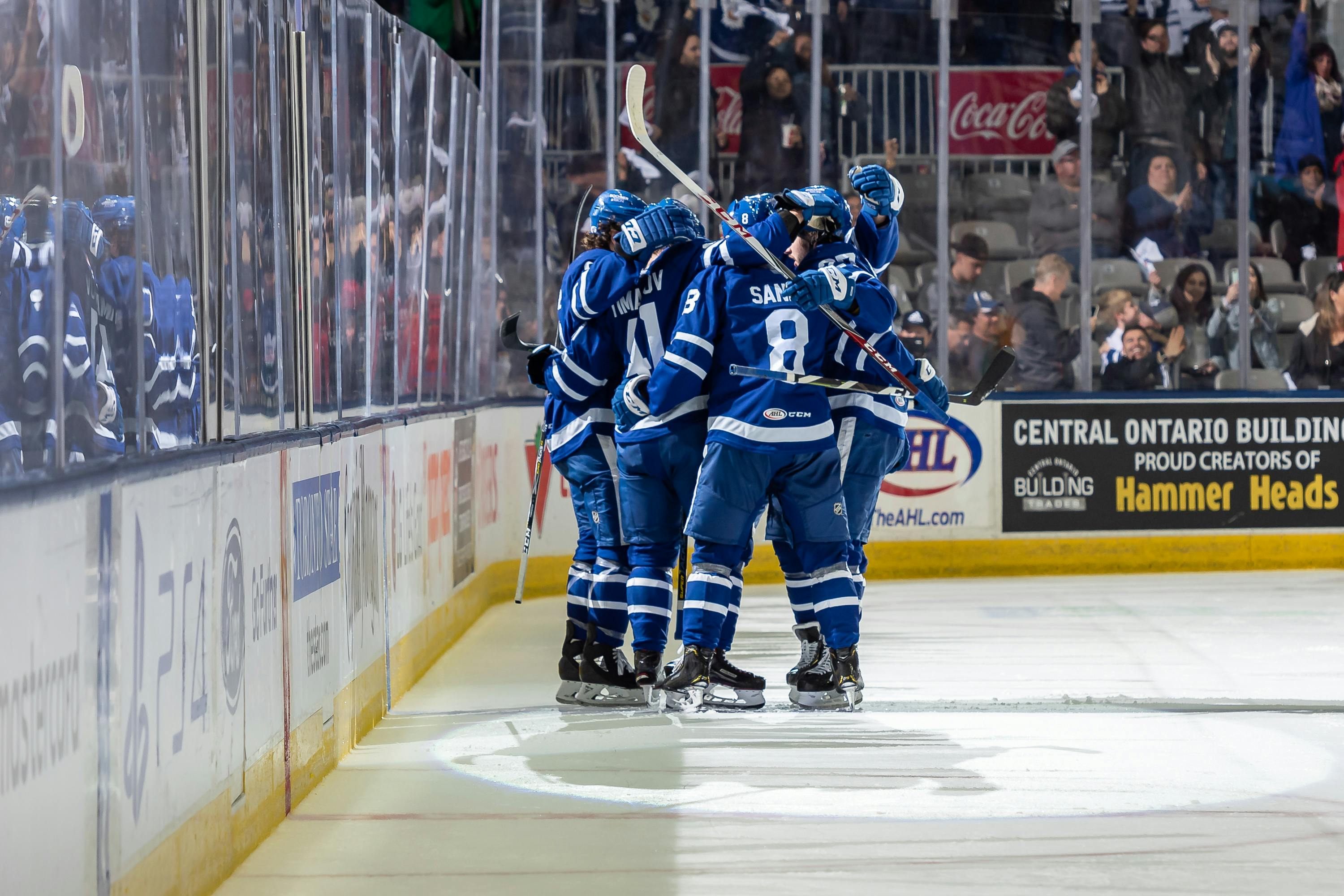How Mitch Marner’s Contract Makes the Marlies Even Scarier

The Mitch Marner saga is over. And with that, we can finally focus on hockey again. Hallelujah.
Upon learning of Marner’s extension, I’m going to guess that you didn’t immediately begin to pine over its potential impact on the Toronto Marlies. Some of you might have done this, of course. Just, not the majority.
Regardless, every move — especially those of Marner’s magnitude — carries a trickle-down effect. Where this one trickles down to, among other places is the Marlies.
The nearly-11 million-dollar-sized chunk Marner’s extension took out of the Leafs’ overall cap sheet was foreseen long before it happened. And that chunk will indeed be as large as advertised, at least for the short-term. Adding $10.893 million to an already capped-out lineup now forces the Maple Leafs into entering this season with a 20- or 21-man roster opposed to their typical 23-man outfit from years past. Three different $10 million+ contracts will do that to you, I guess. Sacrifices must be made.
Still, this is not an insignificant restriction. A 21-man roster (and that’s the generous estimate) means two fewer press-box spares; two fewer press-box spares mean two fewer NHL job openings; two fewer NHL job openings mean two extra players in need of a place to play. You get the idea.
Exacerbating this squeeze is the fact that the Maple Leafs opened training camp a week ago with 17 players signed to sub-$800,000 NHL deals. Of those 17, only two (Jason Spezza and Trevor Moore) can confidently viewed as locks to make the final roster. Space was already painfully tight, and that was BEFORE Marner decided to re-set the RFA market.
Now, a few otherwise deserving hopefuls will inevitably grace the cutting room floor.
This begs the question: Where do hockey players go when there’s no room at the NHL Inn? According to Darren Ferris, that would be Switzerland, but out in the real world, the next logical stop is the AHL — in this case, with the Marlies.
By my estimation, the group of bubble guys with realistic visions of NHL employment this season are Teemu Kivihalme, Nic Petan, Nick Shore, Kenny Agostino, Ben Harpur, Jordan Schmaltz, Martin Marincin, Justin Holl, Garrett Wilson, Kalle Kossila, Pontus Aberg, and Frederik Gauthier.
Some candidates stand a better chance than others, of course (I’d probably wait on buying your Garrett Wilson jersey) but it’s still possible to imagine any of those names on the back of a Leaf uniform on October 2nd, if you really squint hard enough.
Mike Babcock is still the coach of this team, after all. Nothing is set in stone.
A caveat, however: Of the twelve players mentioned above — Kivihmalme being the exception — eleven must first be exposed to waivers in order to be sent down. And aside from helping the coaching staff pare down an NHL roster, that little nugget of info opens the very real possibility that the Leafs could once again watch another team scoop up a few of their pieces once the post-camp waiver period opens; a la Calvin Pickard and Curtis McElhinney a year ago. It will likely be more than one, even.
Given the risks at play here, then, the Marlies obviously won’t be adding twelve quasi-NHL-calibre players to their roster at once before their regular-season starts. Various rules that we’ll get into won’t allow it. But even if that number gets cut in half, — which would require teams to pick Toronto’s waiver wire apart like piranhas on a cow carcass — that’s still a sizeable influx.
NHL Talent on an AHL Roster
When conducting this exercise back in July after the Leafs signed seven players in one day, the Marlies’ forward corps looked a little something like the one below:
Marchment – Brooks – Bracco
Timashov – Kossila – Korshkov
Wilson – Engvall – Archibald
Gaudet – Ferguson – Brazeau
That’s, uh, no longer the case, regardless of who gets nabbed on waivers.
As our cap guru, Earl Schwartz explained so splendidly in his piece from earlier this week, Toronto’s anticipated use of LTIR relief this season will effectively bar them from adding any player to their roster making over $772,301 until the playoffs begin. This carries a few ripple effects. Not only do these restrictions immediately rule out midseason call-ups for any of the organization’s forward prospects not named Dmytro Timashov (who would never see time as a Leaf anyway), it also turns Nic Petan‘s training camp performance into a make-or-break showcase.
Case in point; if Petan isn’t on the Leafs’ roster opening night, he can’t physically be back until mid-April.
Thankfully (for him), most projections peg Petan as a roster piece from the get-go, therein shaping the forward lines as such, per DailyFaceoff:

Assuming the roster plays out this way, a mere two of the seven aforementioned bubble forwards are expected to survive the Cutdown Day carnage, leaving the remaining five with the potential to join the Marlies to begin their seasons.
These may not seem like marquee developments in a vacuum, of course. But when contextualizing them to an AHL roster, well, they’re positively team-shifting.
Each of Agostino, Wilson, Aberg, Gauthier, and Kossila spent extended stints in the NHL as recently as last season, with the latter four all logging upwards of 50 games, respectively. By all accounts, these are NHLers — at least, purely by job description. And regardless of their offensive contributions at that level — Gauthier and Wilson barely registered at all, for instance — adding big-league talent to a minor-league lineup markedly re-shapes its construction.
Funnily enough, a case study already exists to support such a premise. One that sits pretty close to home, too.
When the Marlies decimated the playing field throughout the 2017-18 season and ultimately won their first-ever Calder Cup, their success, in part, stemmed from following a defined blueprint: build the pillars of your AHL roster using (at the time) NHL talent.
It’s not a long-term plan, per se, but those Marlies didn’t really need it to be. Andreas Johnsson and Ben Smith anchored the forward corps; Travis Dermott, Justin Holl and Martin Marincin held up the blueline; Garret Sparks and Calvin Pickard split duties in net. It worked. When the games mattered the most, Sheldon Keefe could solidify his three most vital roster appendages with big fish swimming in small ponds.
Marner’s new contract puts the Marlies in a position to replicate that in 2019-20, albeit to a somewhat lesser extent.
Standing in their way this time is the AHL’s pesky veteran rule, a stipulation that limits teams to a maximum of five players with over 260 career professional games in a nightly lineup. Aberg, Gauthier, Wilson, and Agostino each fit this bill. So, if the Marlies intended on dressing those four as regulars, it would then require other quality veterans like Darren Archibald and Tyler Gaudet upfront, and even Martin Marincin and Justin Holl (also likely cutting day casualties) on the back-end to sit, not to mention cutting into the available reps for the organization’s litany of prospects.
This is where the possibility of a waivers purge might actually come in handy. Assuming that another team helps whittle down that group by one or two names, the Marlies can then ice a compliant AHL roster along the lines of:
Marchment – Brooks – Bracco
Timashov – Kossila – Aberg/Agostino
Wilson – Gauthier– Korshkov
Gaudet – Engvall– Brazeau/Archibald
Sandin – Liljegren
Marincin/Kivihalme – Holl/Hollowell
Gravel – Duszak/Johnston
Hutchinson
Kaskisuo/Woll/Scott
By AHL standards, that’s incredibly daunting. From the top of the lineup down to even its lowest rung, each position group harbours NHL-calibre talent at the forefront while simultaneously drawing support from emerging prospects. AKA; the perfect mix.
The thought of waivers, in this case, might even be a best-case scenario. Sacrificing a few bodies to the masses would, in theory, clear space for intriguing projects like Justin Brazeau and Brady Ferguson to earn regular spots for themselves. And yet, even if the Leafs ultimately make it out of the waiver period unscathed, the Marlies will still have the ability to cycle both players into the lineup periodically while further committing them to strict developmental plans outside of the pressure of an in-game environment.
What many once projected as the youngest Marlies roster in years has, thanks to Marner’s contract, now been cloaked with some adult supervision. And when the organizational “process” hinges upon building a winning environment in which to incubate prospects, that might not be a bad thing, either.
Isn’t it fun to talk hockey again?
Recent articles from Mike Stephens





